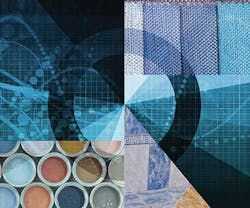Even for the most sustainably aware designers, keeping track of all of the rules and regulations can be confusing. And if you’re new to Environmental Product Declarations (EPDs), they can be nearly impossible to navigate. Luckily, there are experts for that. i+s sat down with two third-party certifiers, Jenny Oorbeck, general manager, Sustainability, NSF International; and Anna Lasso, product manager, Environmental Product Declarations, UL Environment LLC, to discuss the ins and outs of how EPDs will continue their influence on the design industry.
From the Experts...
EPDs benefit us as well as our customers. The rigor of completing an EPD helps us pinpoint where our materials and processes have the most environmental impact, allowing us to continue to move toward solutions with a lower footprint. Externally, these allow our customers to compare transparent environmental data regarding the products they buy in order to make more informed environmental
product-specification decisions.
—Russ Delozier, Director of Sustainability, J+J Flooring Group
Because EPDs are third-party certified through a series of product category rules, Universal Fibers views them as a simplified external reporting tool for our customers and the marketplace to communicate a product’s sustainability attributes. For internal decision-making [product development choices, ISO 14001 improvement initiatives, etc.], LCAs provide a greater level of technical detail.
—Brendan McSheehy, Vice President of Innovation, Sustainability, IP, Universal Fibers
At Mohawk Group, we believe that product transparency is essential for healthy, productive workplaces. That’s why we’re seeking greater product transparency by supporting and utilizing third-party platforms, such as EPDs, that provide all of us with a common language and measurement about life-cycle environmental impact of products. Not only are EPDs essential for helping architects, designers, and end users make the right choice during the specification process, EPDs also bring peace of mind to the occupants of these buildings because they know they’re surrounded by products that contribute to healthy spaces.
—George Bandy, Vice President of Sustainability, Mohawk Group
EPDs are not meant to be business-to-consumer communication. They’re not prohibited, but it’s mainly business-to-business communication. They seem to be easy to understand, but there are many different aspects. The intention is to be comparable, but we’re not there yet. There
is progress toward mutual recognitions, but mutual recognition is only possible when you have the same rules. So the way in which we use EPDs at Aquafil is to compare our own products. We are always looking at the benefits between our products.
—Lucjia Aleksic, Sustainability Compliance Manager, Aquafil
PageBreakWhat are EPDs?
“An Environmental Product Declaration is a standardized report (developed in accordance with ISO 14025) outlining the results of data collected in a life cycle assessment (LCA) that must contain information as defined in a product category rule (PCR),” Oorbeck said. Or, simplified, “EPDs are often compared to a nutrition facts panel for a product’s environmental performance.”
Lasso added, “EPDs are there to transparently present the environmental impacts of a product from cradle to grave, across the entire value chain. We’re quantifying everything that goes in—energy, water, materials—and everything that comes out: emissions to land, air, and water.”
She continued in explaining that the history of LCAs is rooted in studying a common question: Which products are environmentally preferable? Consider cloth or disposable diapers. As one of the first studies done in the late 1970s to early 80s, the thought was that cloth would be better environmentally. However, once figuring in all of the aspects—from petroleum refining to the energy needed to heat the water in order to correctly launder the cloth diapers—a different story began to arise.
How do manufacturers use EPDs?
The use of EPDs today in the A+D community follows that same mindset as the studies on diapers. “[An EPD is] different in that it’s absent of a value judgement,” Lasso said. However, while an EPD doesn’t state whether something is intrinsically good or intrinsically bad, “the value of EPDs lies in the fact that companies are measuring their environmental impact. You can’t manage what you aren’t measuring.”
Furthermore, Oorbeck said, “With an LCA, a manufacturer can benchmark the performance of alternative materials, product designs, or packaging systems to identify best performance, lowest environmental impact, and money-saving scenarios. EPDs allow manufacturers to provide transparency about their product attributes to help end users make informed environmental purchasing decisions.”
How should the A+D community use EPDs?
It’s this transparency that makes EPDs so valuable to the A+D community as LEED v4 becomes more prominent. New sustainability efforts will look beyond previous criteria to the full life cycle of a product, which means knowing more about the background of the product.
Can someone adequately compare EPDs?
“Right now, EPDs are largely seen as just checking a box; ‘OK, we did this, we qualify for LEED or other green building scheme points,’” Lasso noted. While the eventual goal is to be able to compare two products by two different companies using EPDs, and there are current PCRs that exist for their creation so there is some consistency, “they only go so far in being prescriptive on how you do your study.”
As an example, Lasso said UL Environment had two third-party analysts study the same product by the same manufacturer, and found the results came back with a difference of up to 300 percent.
One reason lies in the fact that while EPDs may follow particular ISO rules and PCRs, the background research—how, where, and when the upstream petroleum production was collected and aggregated, for example, or how water use was measured—are not currently consistent between different LCA background datasets. This means one company might use a different background dataset than another, meaning its EPDs cannot be comparable because of that underlying variation.
That doesn’t mean the numbers lack substance or importance. While datasets between companies are not standardized at the moment, they tend to be within a particular company, making them a strong indicator of how a manufacturer is doing within its own product lines. “They can learn the hot spots and begin to address mitigating,” Lasso pointed out.
Similarly, it’s important for designers to embrace EPDs, particularly as they become a more globalized standard of measurement. When designers understand what goes into a product, they’re able to make more informed decisions and hold manufacturers to a higher expectation that they are doing what they can to address issues in their products’ life cycles.
About the Author

Kadie Yale
Former Editor-in-Chief
Kadie Yale holds a BA in Industrial Design from San Francisco State University and a MA in Decorative Art History and Theory from Parsons the New School. In her role as editor-in-chief from 2015-2018, she led the interiors+sources team in creating relevant content that touches on sustainability, universal design, science, and the role of design in society.
